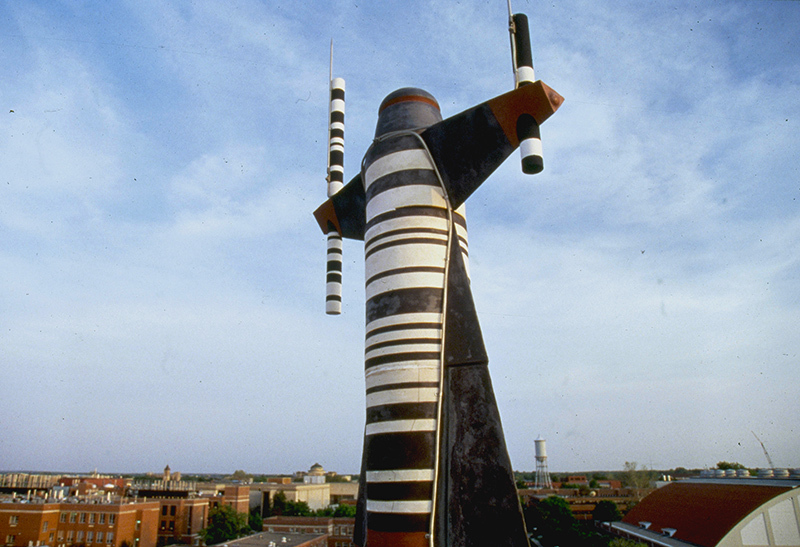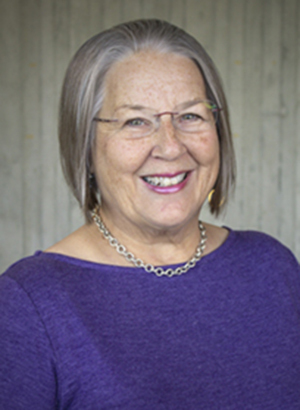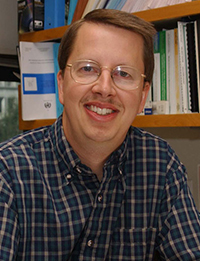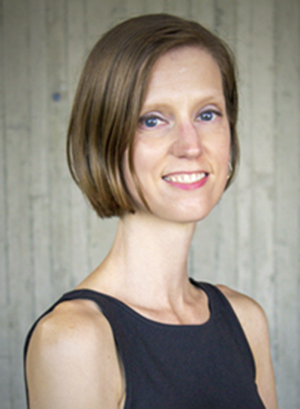Surprise! Museums' visual literacy uses a scientific process
Author: Anne Krapfl
Author: Anne Krapfl

One of artist Andrew Leicester's G-Nome sculptures atop Molecular Biology Building, part of Iowa State's Art on Campus collection. Submitted image.
Learners can apply the scientific method -- collect data, interpret and finally evaluate the information -- to unfamiliar images the same way they do words or numbers. That's the premise for the visual literacy program at university museums.
"It's exactly what scientists do, it's their process," said director Lynette Pohlman. "We use a different vocabulary in visual literacy, but it's the same process: You hold off on your evaluation until you better understand what you're looking at."

Pohlman
And because university museums' primary purpose is not to curate art exhibitions, but to support the university's mission of educating students, Pohlman said her staff wants to reach more students by working with more faculty to integrate visual literacy into a class session. Seven museum staff members and eight trained docents are available to lead visual literacy discussions, a question-answer process to collect data. The program is free for campus.
Classroom instructors have access to the 30,000-plus works of art in the museums' collections -- paintings, sculptures, textiles, glass, pottery, prints and more -- to build their students' critical thinking and communication skills. More than 2,500 of those works of art, the Art on Campus collection, are in indoor and outdoor public spaces. Depending on faculty's selections, some art also may test students' understanding of concepts in their academic discipline.

Gallus
For example, professor of geological and atmospheric sciences Bill Gallus understandably is drawn to paintings with a weather story to tell.
"Art is a really good vehicle for getting our students to think deeply about a subject matter and doing it in a way where they take the time to collect the data and interpret it, before they jump to some conclusion," Gallus said. "Visual literacy is not about whether they like a piece or not."
"You have to beware of any 'edutainment' expectations among students," he added. "I use it to make them really think -- or to reinforce something they've learned about the subject matter."
Gallus has a one-year appointment as a faculty affiliate with the Center for Excellence in Learning and Teaching, focused on expanding visual literacy in the STEM fields. University museums received a 2024 grant through the 2022-31 strategic plan's competitive proposal process to fund the part-time position.
His assignment is to encourage faculty to weave visual literacy into their instruction.
"Once you've created a class, I know it's difficult to choose something to remove to make time for this," Gallus said. "Visual literacy really is another take on the scientific process, and it's worth trying to work it into your syllabus."

Gennett
The best thing about those 30,000 works of art in the university museums collection? Faculty don't have to review them all to select what they'd like to share in their class. Contact the museum staff, tell them what you're teaching and what you're interested in to supplement it.
"We can integrate our collections into your curriculum in about any way you could imagine," said Adrienne Gennett, curator of the Brunnier Art Museum who coordinates visual literacy efforts and works with faculty to learn how visual literacy can fit into post-pandemic learning methods. "We're quick to say yes, and then we figure it out. We try to make access as easy as possible."
To help narrow the selection process for STEM faculty, she and Gallus created object packages -- folders of art recommendations for courses in the life sciences or physical sciences. Find them among other packages on the museums' collections database.
Pohlman said her team frequently uses the nine Grant Wood panels in a Parks Library staircase, "When Tillage Begins Other Arts Will Follow" to introduce visual literacy.
"It's accessible, it tells a narrative, contains history, it's less daunting and has some commonality with us -- as opposed to abstract art, which makes us think and feel harder," she said.
Several other large, public works of art have been used successfully and broadly in visual literacy sessions across academic disciplines: G-Nomes by Andrew Leicester atop the Molecular Biology Building, Floating World by Ralph Helmick in the Biorenewables Complex atrium, and "Breaking the Prairie Sod," also by Grant Wood, in Parks Library.
Nearly as old as university museums -- which celebrates 50 years this fall -- visual literacy at Iowa State had its start in 1976 when museums staff partnered with the former College of Education to train both student teachers and museums docents on understanding and learning to talk about art. Earlier that year, Pohlman observed visual literacy in action at the Boston Children's Museum.
But Iowa's Art in State Buildings legislation (1979-2017) gave it flight. The law required one-half of 1% of the budget for state construction projects be reserved for fine arts in the building. On this campus, that legislation added 183 public works of art to the Art on Campus collection. Just as important, it drew more than 1,700 faculty, staff and students into the public art process, one committee at a time.
"Art on campus is a democratic process. The museums' role is to provide a professional pool of public artists, but the people on the committees make the decisions," Pohlman said. "By the time they commission a public work of art, they have visual literacy under their belts."
She recalled an early project, the east addition to Agronomy Hall in the early 1980s. Department chair John Pesek put all 26 of his (male) faculty members on the public art committee, and the discussion evolved from bronzing a tractor to commissioning a bronze sculpture, Janus Agri Altar, by female artist Beverly Pepper for the Agronomy courtyard.
"For the next 10 years, we had more agronomy students in the museum than any other department. The faculty got it, and they incorporated what they learned," Pohlman recalled. "It was a powerful lesson for us at the museum."
In spring 2000, a class project by a museums student intern proved pivotal in reaching large numbers of freshmen and sophomores consistently. The intern surveyed English 150 instructors about their awareness of university museums and understanding of visual literacy. She sold them on the concept of using museum tours and visual literacy to strengthen the writing process, and suddenly museums staff were doing about 90 tours per semester for introductory writing students.
By 2019, Pohlman said museums staff and docents were reaching 43 to 63 university departments each year. Who those were often trailed the public art commissions -- or was influenced by senior faculty who were visual literacy advocates and had some latitude to tweak course curricula to create space for it.
And then came 2020. Among its many impacts, the COVID pandemic sent instruction online and brought a hard stop to in-person tours and classroom visual literacy discussions. Numerous regular faculty users of the visual literacy program retired. Pohlman said the restart has involved new strategies -- such as Gallus' position -- and collaborations with a new set of faculty instructors.